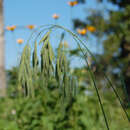pt-BR
nomes no trilho de navegação


Bromus kalmii, the Arctic brome or prairie brome, is a species of brome grass. It is a native bunchgrass in the North-central and Northeastern United States, the Great Lakes region, and eastern Canada. The specific epithet kalmii refers to its discoverer Pehr Kalm.
Bromus kalmii is a perennial grass, with solitary or slightly tufted culms that grow 0.4–1.2 m (1 ft 4 in – 3 ft 11 in) tall. The culms are pubescent just below the nodes. The grass typically has three to five and occasionally six leaf blades. The firm and scabrous leaf blades are either pubescent or glabrous and are 7–17 cm (2.8–6.7 in) long and 4–10 mm (0.16–0.39 in) wide. The glabrous or sometimes shaggy sheaths are mostly shorter than the internodes and each have a "V" shaped cleft. The ligule is typically 0.5 mm (0.020 in) long. The narrow, crowded panicle is 5–15 cm (2.0–5.9 in) long. The lower branches of the panicle are very slender and each bear one or two spikelets. The five to eleven flowered spikelets are 1.4–2.6 cm (0.55–1.02 in) long and 5–6 mm (0.20–0.24 in) wide. Both glumes have short, adpressed hairs. The lower glume is three-nerved and the upper glume is five-nerved. The densely hairy lemmas are oblong to elliptical in shape, and have straight awns 1–3 mm (0.039–0.118 in) long. The oblong and flat palea is slightly shorter than the glume. The anthers are approximately 2 mm (0.079 in) long.[2][3]
The grass flowers from July to through August.[4]
Bromus kalmii grows in dry or moist open areas or thickets, especially on calcareous soils.[2][5]
Bromus kalmii, the Arctic brome or prairie brome, is a species of brome grass. It is a native bunchgrass in the North-central and Northeastern United States, the Great Lakes region, and eastern Canada. The specific epithet kalmii refers to its discoverer Pehr Kalm.
Bromus kalmii, es una especie herbácea perenne perteneciente a la familia de las gramíneas (Poaceae).
Es una planta perenne de corta duración de aproximadamente unos 60 cm de alto y no ramificada. Forma matas de hojas y produce tallos con flores. Cada tallo es verde, delgado y redondo en sección transversal, o bien es glabra, poco peludo, o ligeramente pubescentes. Los nodos de los tallos son generalmente pubescentes. Cada tallo tiene 3-5 hojas alternas a lo largo de su longitud en el momento de floración. La hoja de cada hoja caulinar es azul grisáceo, lineal y plana o enrollada hacia arriba a lo largo de los márgenes. La superficie superior de cada lámina de la hoja está en su mayoría sin pelo, aunque los pelos largos están a menudo presentes cerca de sus márgenes o a lo largo de la vena central de su cara inferior. Los márgenes de la lámina de la hoja son suaves en apariencia, pero áspera al tacto. Cada hoja tiene una vaina abierta que es azul grisáceo y generalmente muy peluda o pubescentes.
Bromus kalmii es nativa del norte-centro y noreste de Estados Unidos, la Región de los Grandes Lagos y el este de Canadá.
Bromus kalmii fue descrita por Asa Gray y publicado en A Manual of the Botany of the Northern United States 600. 1848.[2]
Bromus: nombre genérico que deriva del griego bromos = (avena), o de broma = (alimento).[3]
kalmii: epíteto otorgado en honor del botánico Pehr Kalm.
Bromus kalmii, es una especie herbácea perenne perteneciente a la familia de las gramíneas (Poaceae).
Bromus kalmii là một loài thực vật có hoa trong họ Hòa thảo. Loài này được A.Gray mô tả khoa học đầu tiên năm 1848.[2]
Bromus kalmii là một loài thực vật có hoa trong họ Hòa thảo. Loài này được A.Gray mô tả khoa học đầu tiên năm 1848.